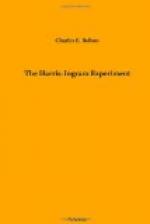Mariposa, Spanish for butterfly, was a fit name for the pretty Indian maiden. She paid great deference not only to her tall father, Red Cloud, but to the pale faces whenever in their presence. For four years Mariposa, unusually bright, attended the Indian school at Carlisle, Pa.; when she returned to her wild home in the forest she was able to speak and read the language of the pale face, and beside she loved history and poetry.
One day, Alfonso’s health having slowly improved, Mariposa put in his hands a small pine cone, the size of a hen’s egg, and said, “Three years go by from the budding to the ripening of the seed of the sequoias, or big trees.”
Alfonso did not know, till Mariposa told him that the big trees were called sequoia in honor of a Cherokee chief, Sequoyah, who invented letters for his people. She also told Alfonso that there were at least ten groves of big trees on the northern slope of the Sierra Nevada range; that some of the trees were thirty feet in diameter, and 325 feet in height; that sixteen Yosemite braves on their ponies had taken refuge from a terrible storm in the hollow of a single sequoia. Alfonso prized highly a cane, fashioned by the Indian maiden from a fallen Big Tree. The wood had a pale red tint, and was beautifully marked and polished.
Part of the Indian hunting party went forward with the game, while Mariposa, Red Cloud, and three Yosemite braves with their ponies, waited for the handsome pale face to recover partially. Then they rode with Alfonso among the Big Trees, past Wawona, toiling up long valleys, stopping now and then to cook simple food. The Indians followed a familiar trail up dark gulches, along steep grades, through heavy timber, skirting edges of cliffs and precipitous mountains, the ruggedness constantly increasing, till suddenly Mariposa conducted Alfonso to a high point where his soul was filled with enthusiasm. Mariposa, pointing to the gorge or canyon of extraordinary depth, which was floored with forest trees and adorned with waterfalls, said, “Here in the Yosemite (grizzly) Valley is the home of my people. Here we wish to take you until you are well. Will you go?”
Alfonso, still weak and pale, but trusting the Indian girl, replied “Yes.” The young artist-miner had never seen such stupendous masonry; the granite walls that surrounded the valley were a succession of peaks and domes, from three thousand to four thousand feet high, all eloquent in thought and design. Alfonso began sketching, but Mariposa motioned him to put his paper aside, and the six Indian ponies with their burdens carefully picked their way into the paradise below.
Red Cloud, Mariposa, Alfonso, and the braves were received with expressions of joy unusual for the stolid red men, and Alfonso was given a tent to himself near the chief’s big tepee, close by a broad clear stream, and in the shadow of large old oaks. Here for several days Alfonso tarried, grew stronger, and often walked with pretty Mariposa. She taught him a novel method of trapping trout which thronged the river. She had him sketch the reflection in Mirror Lake of cathedral spires and domes, of overhanging granite rocks, and tall peaks of wildest grandeur.




